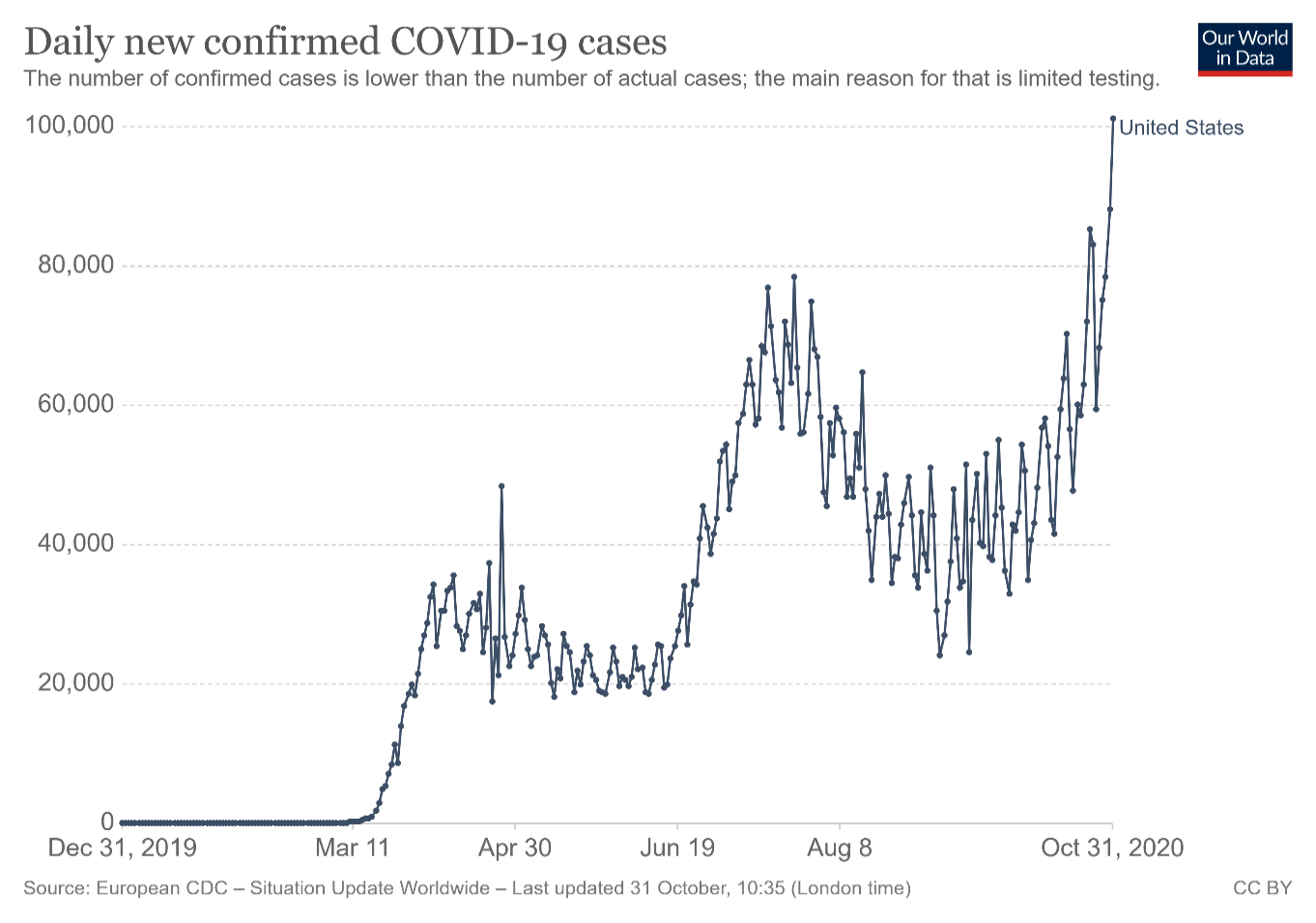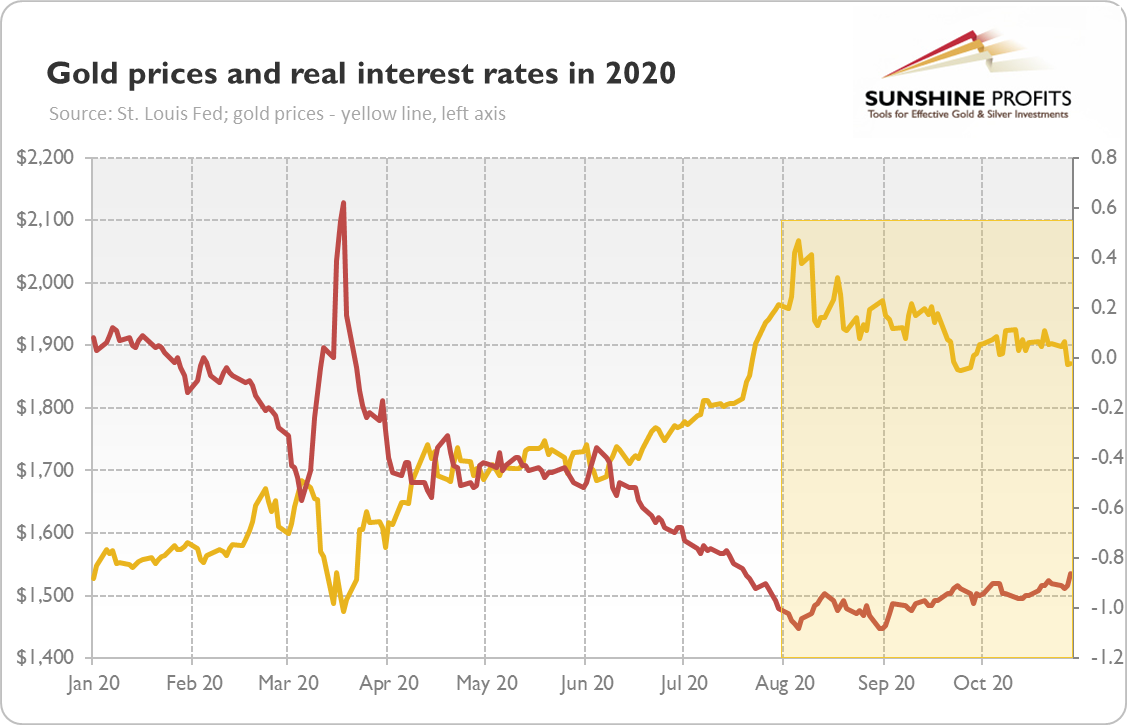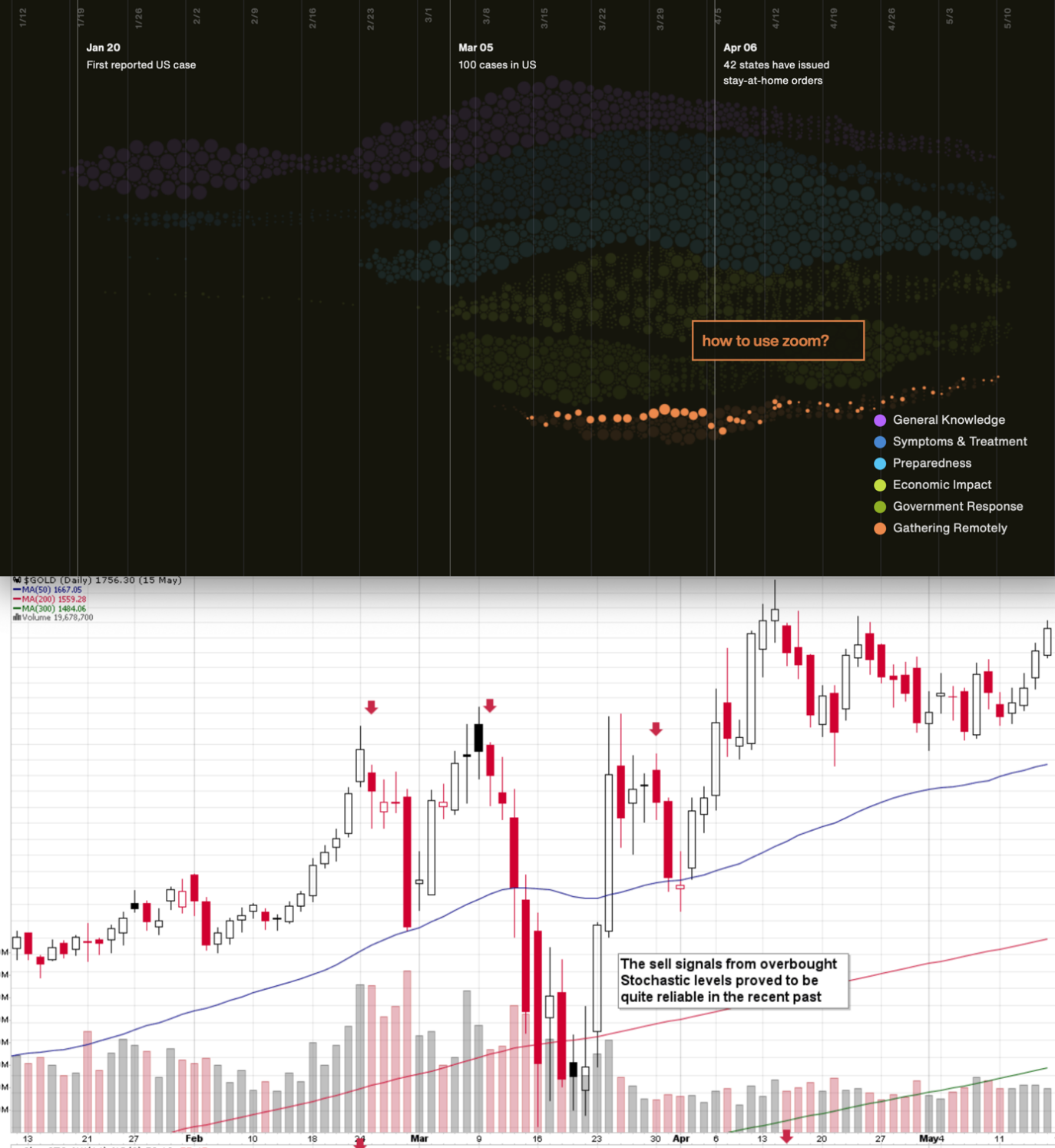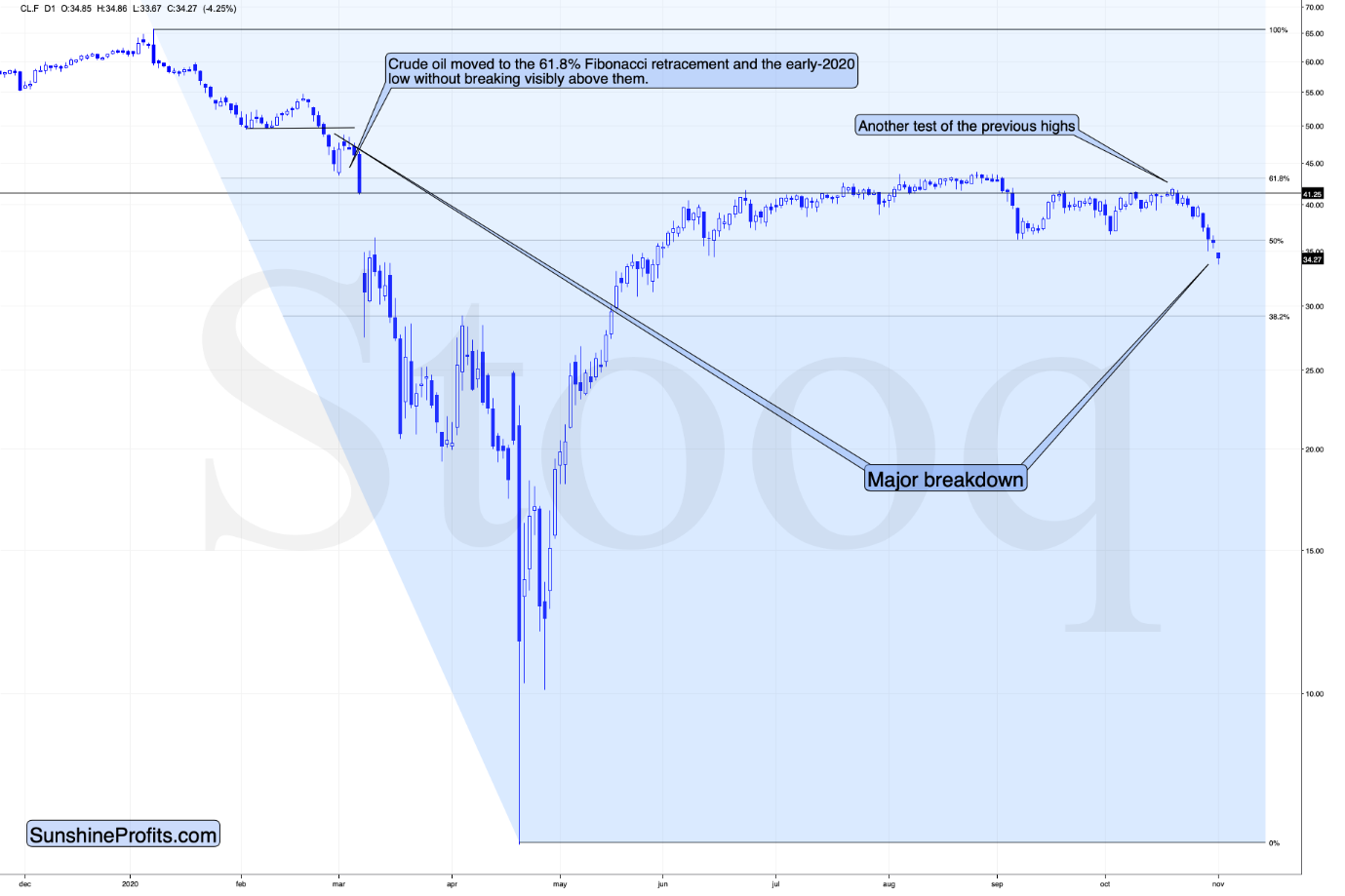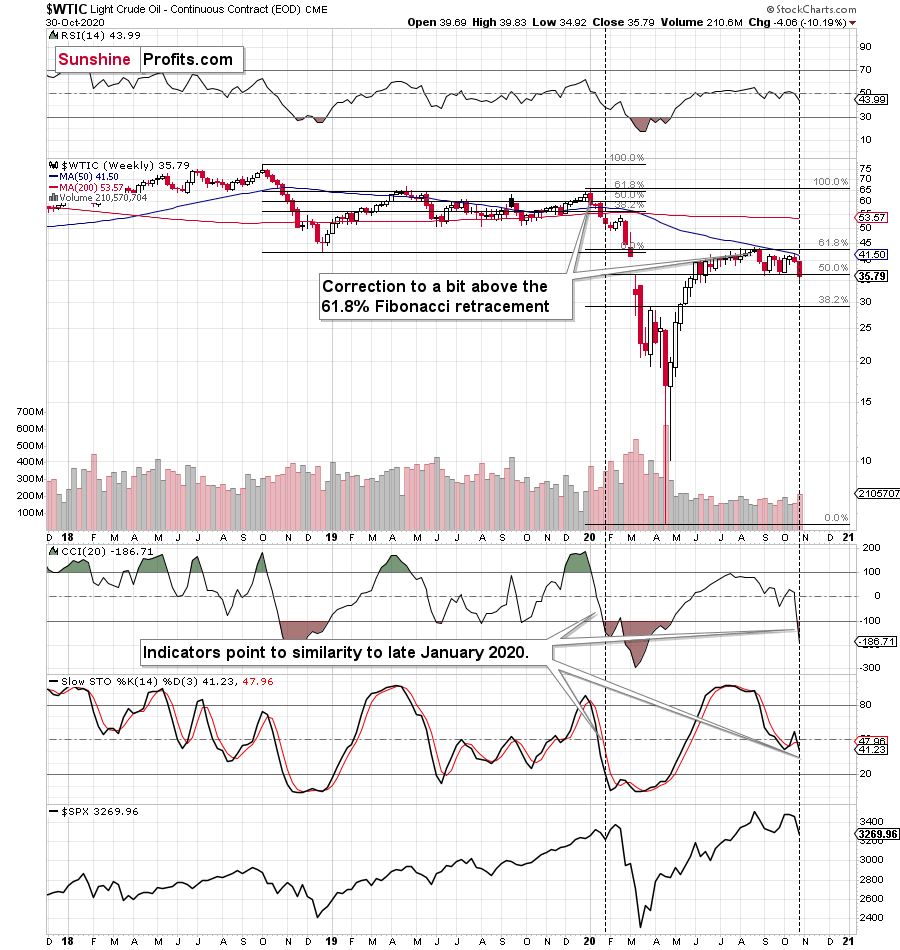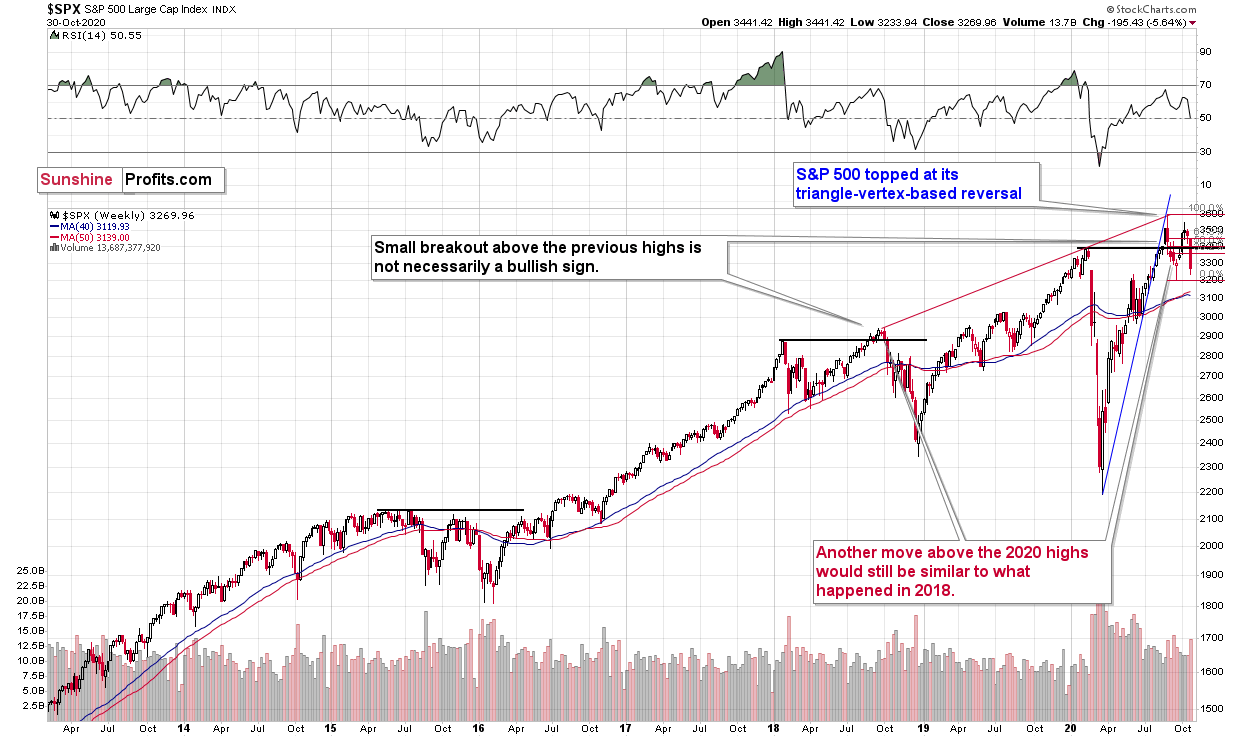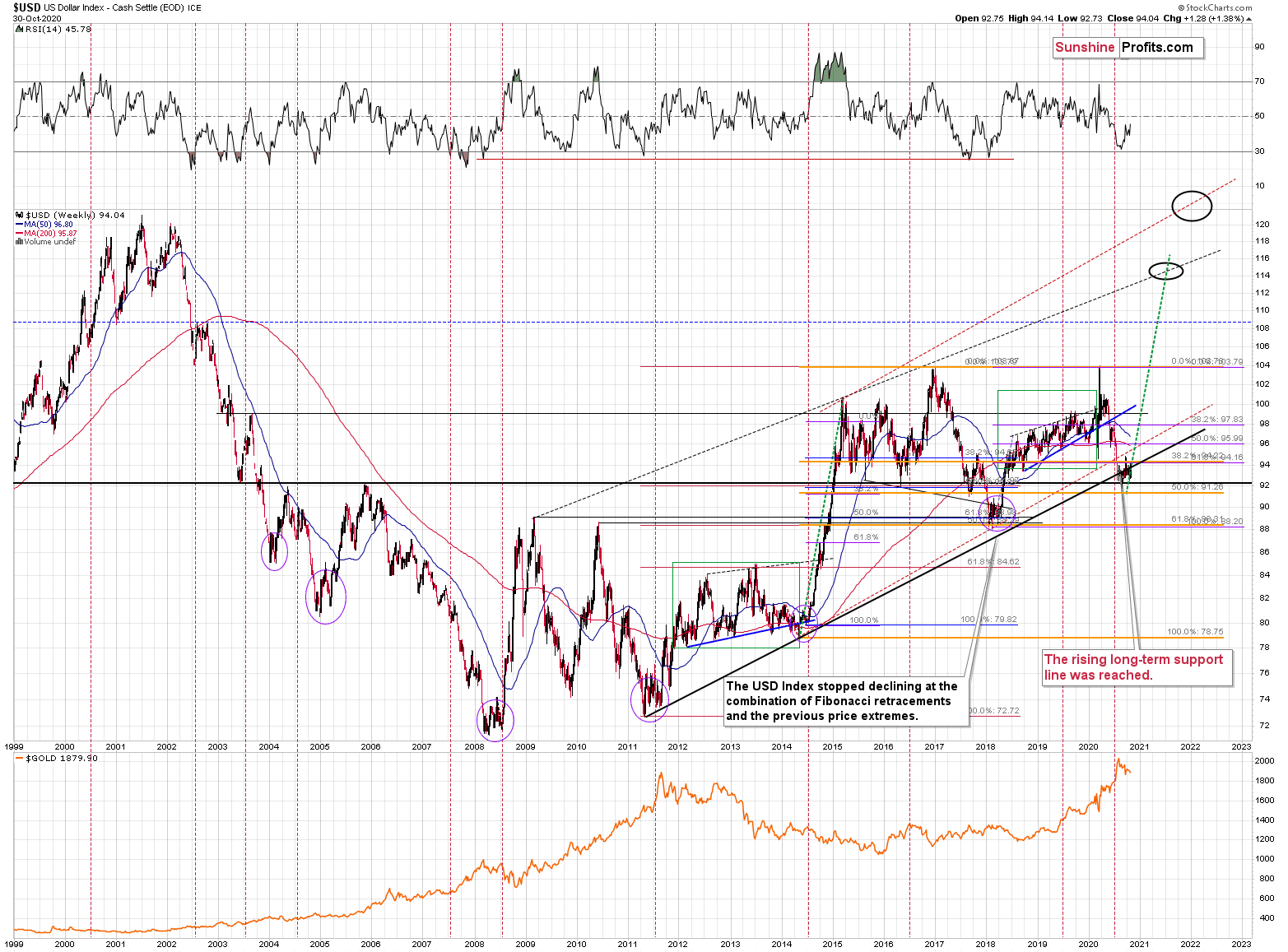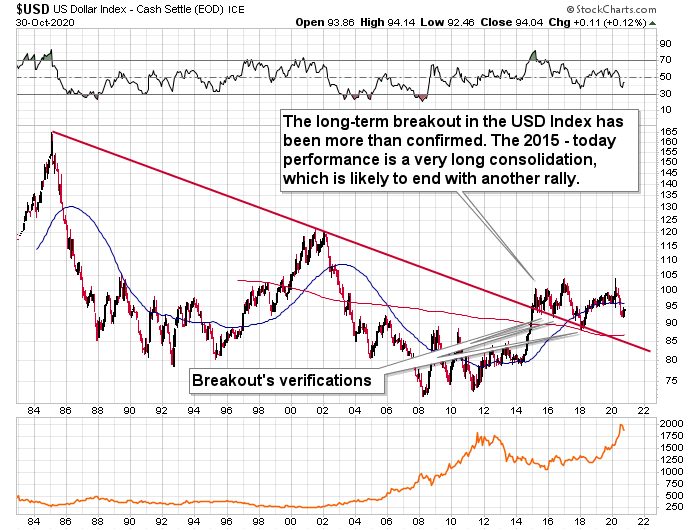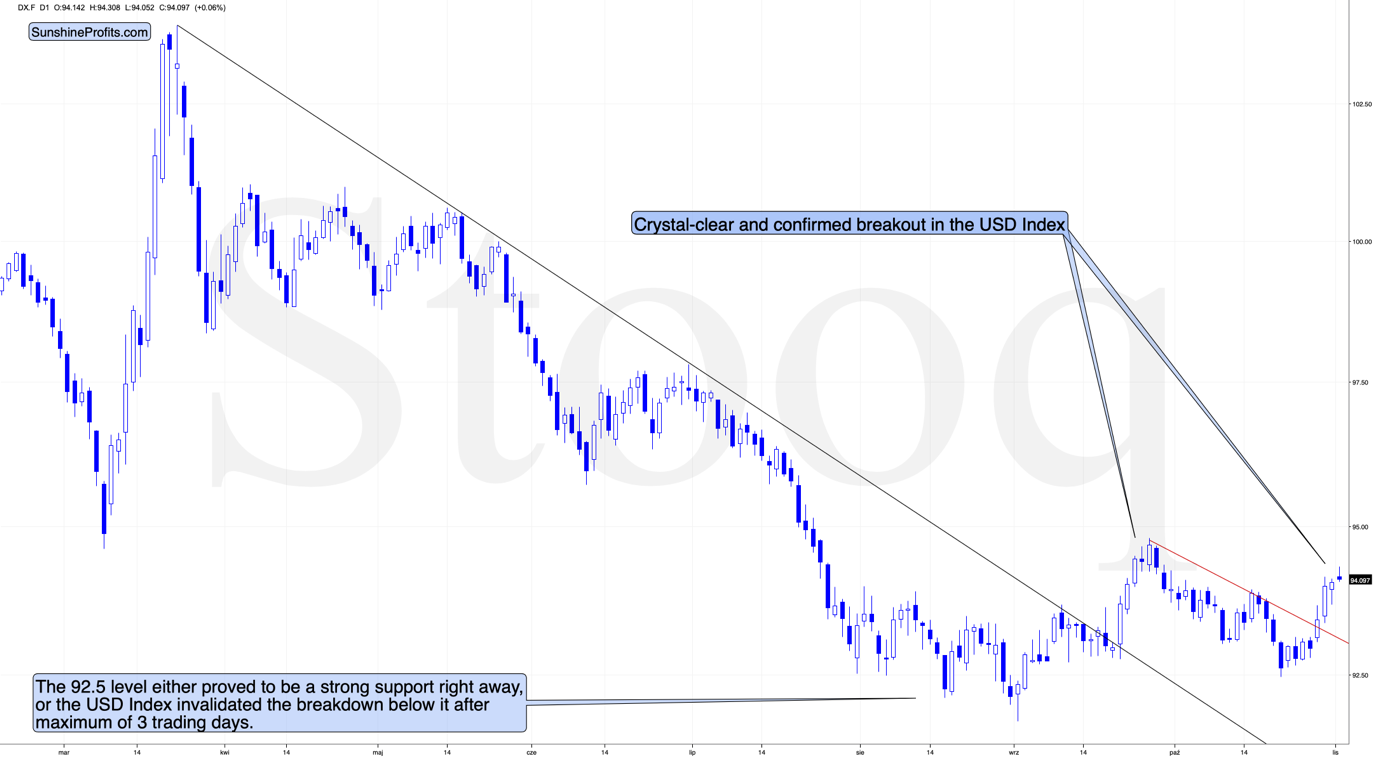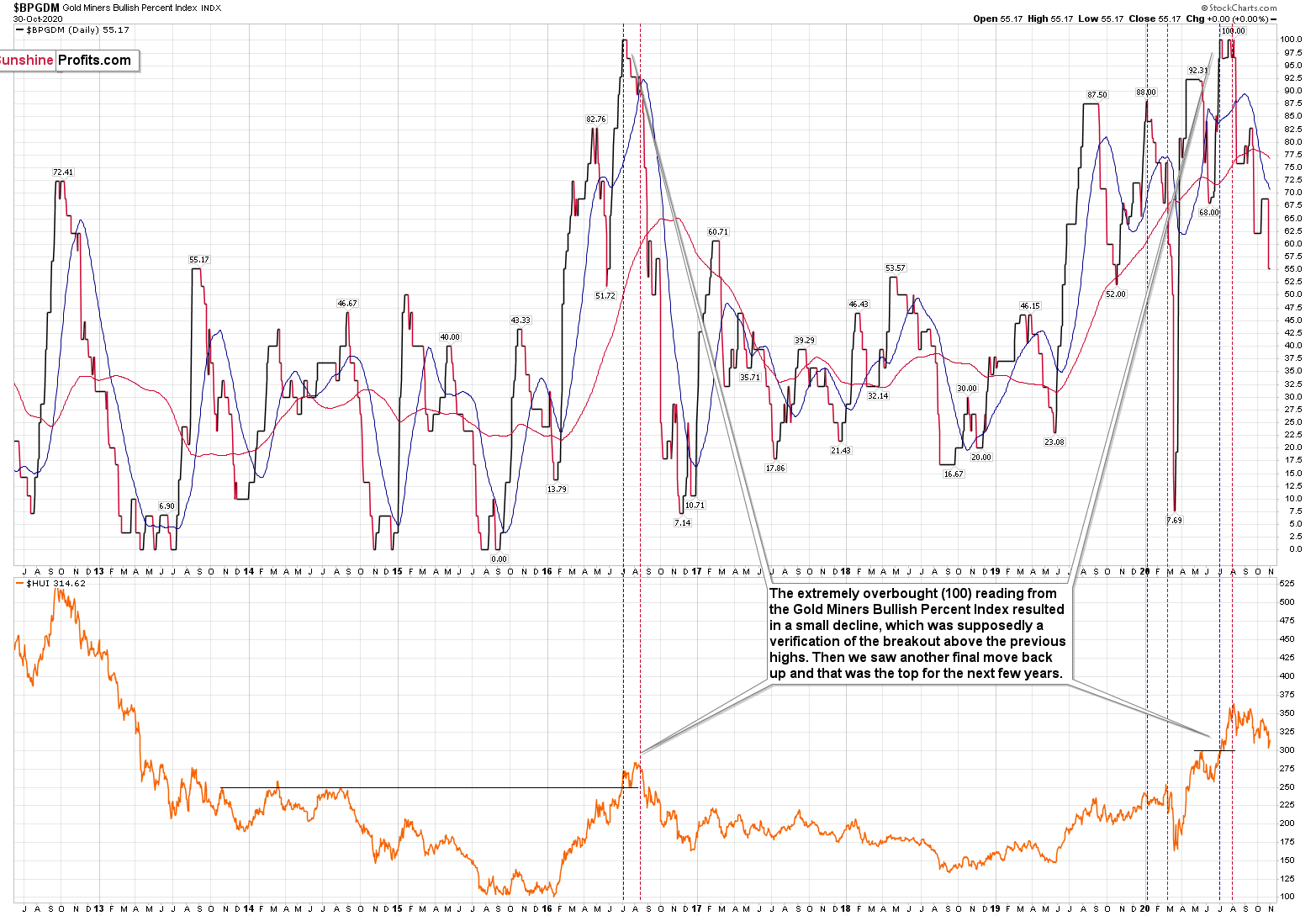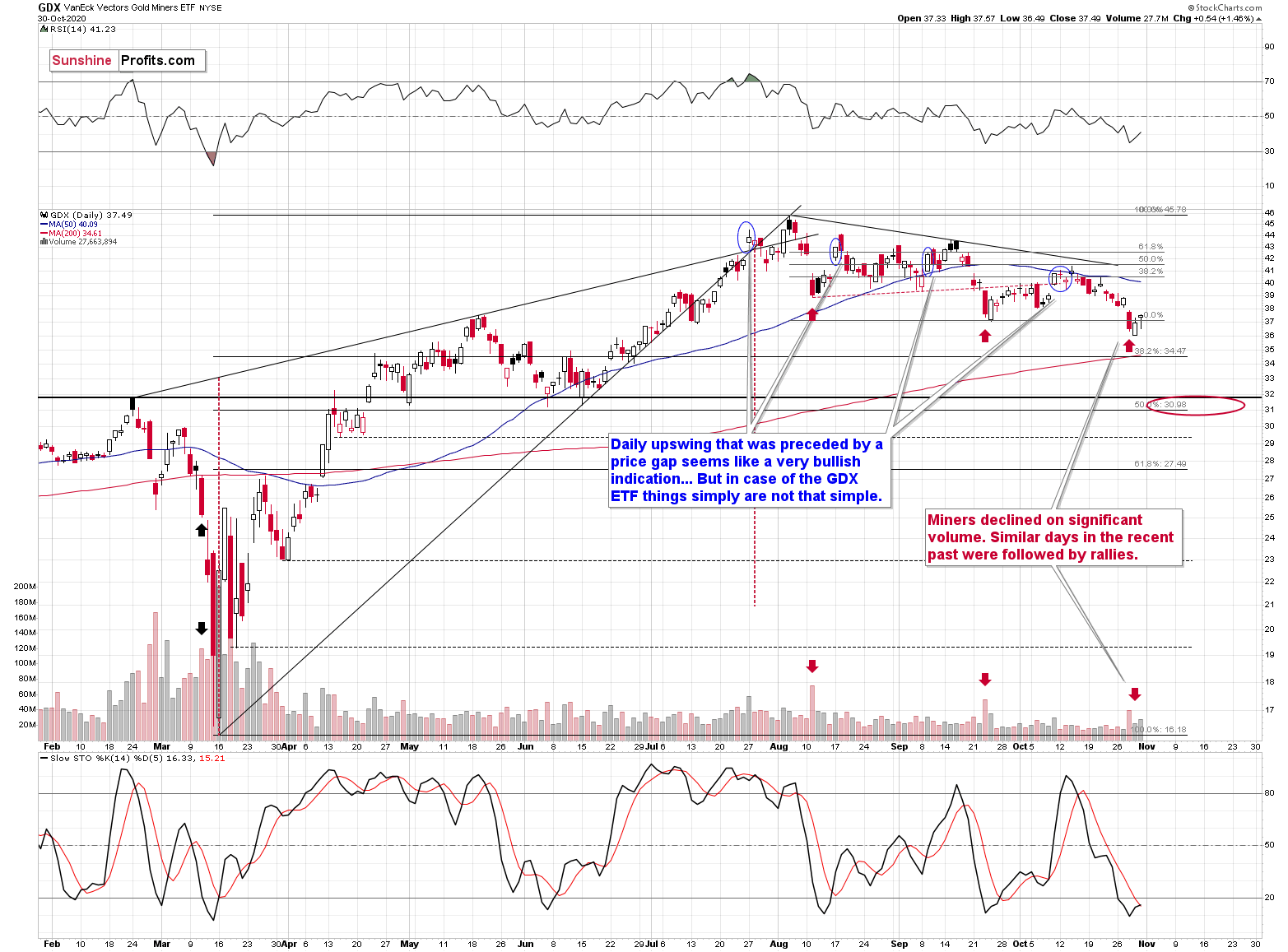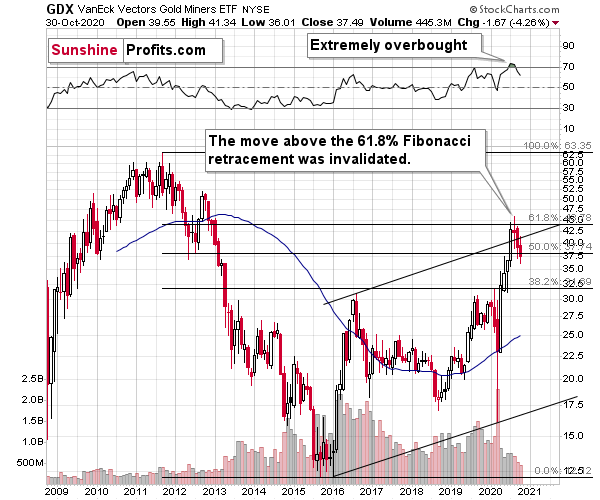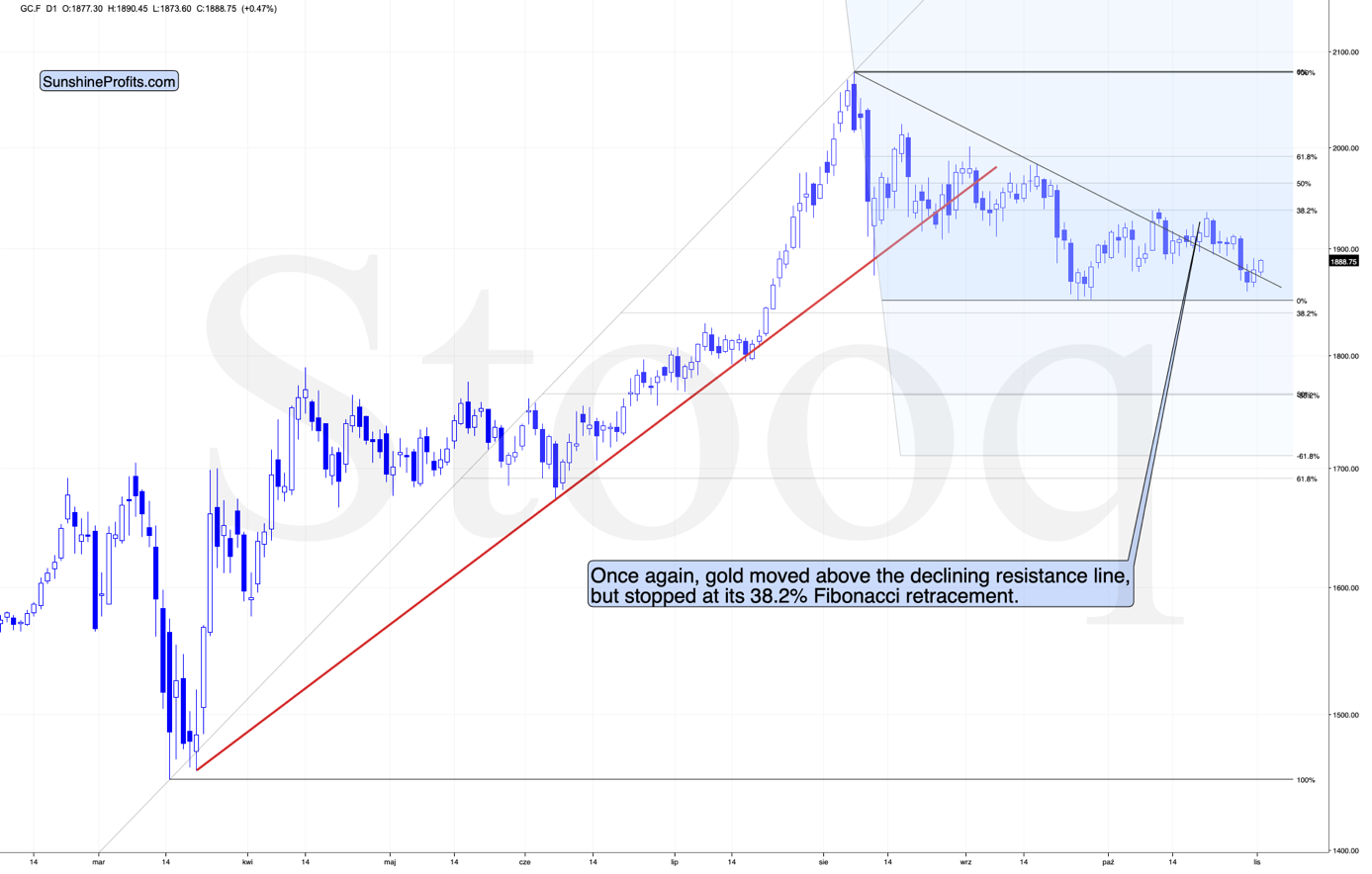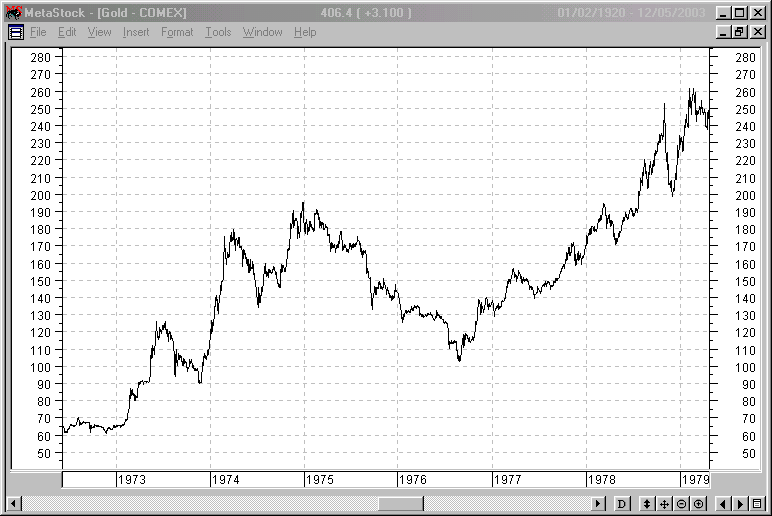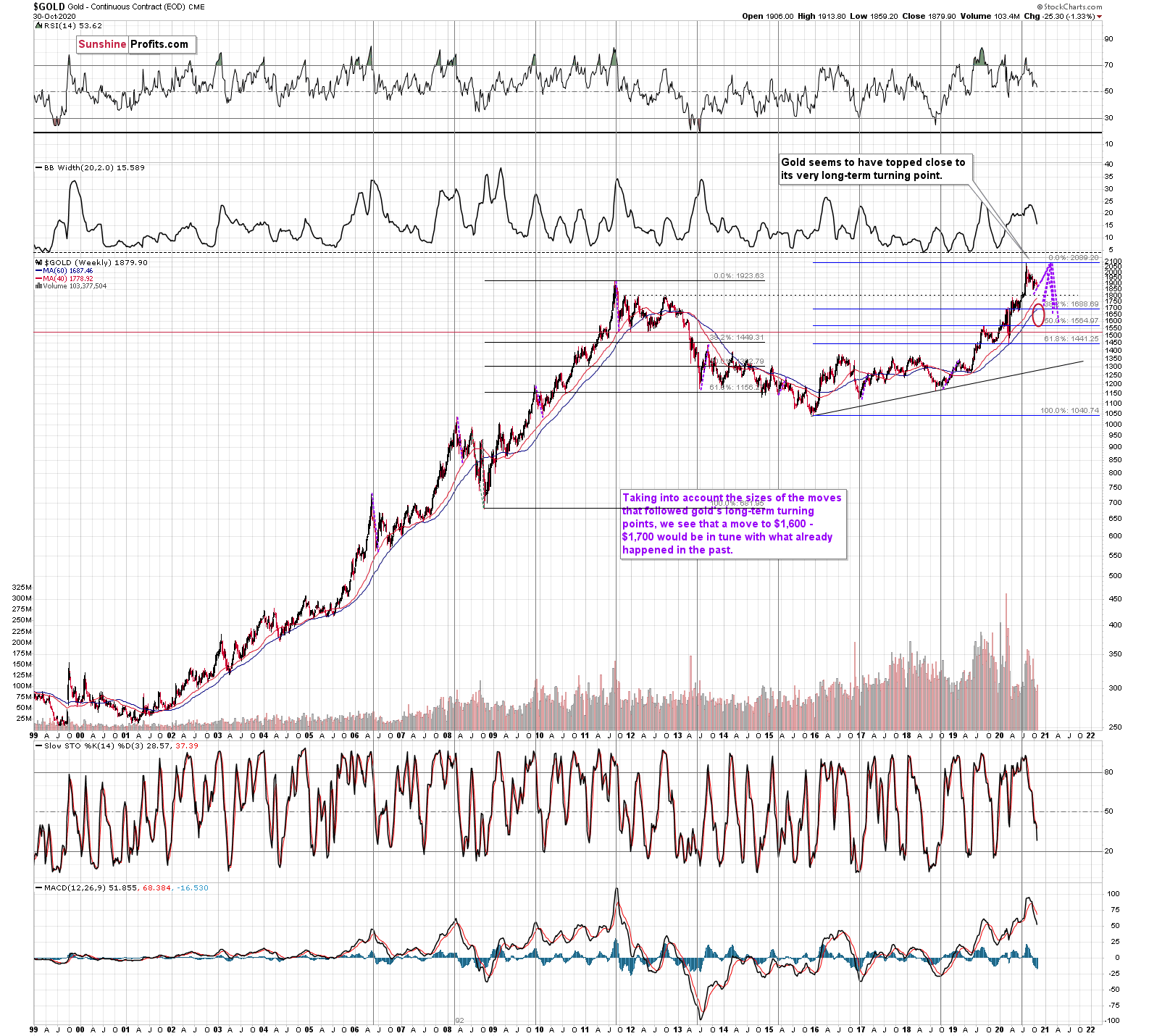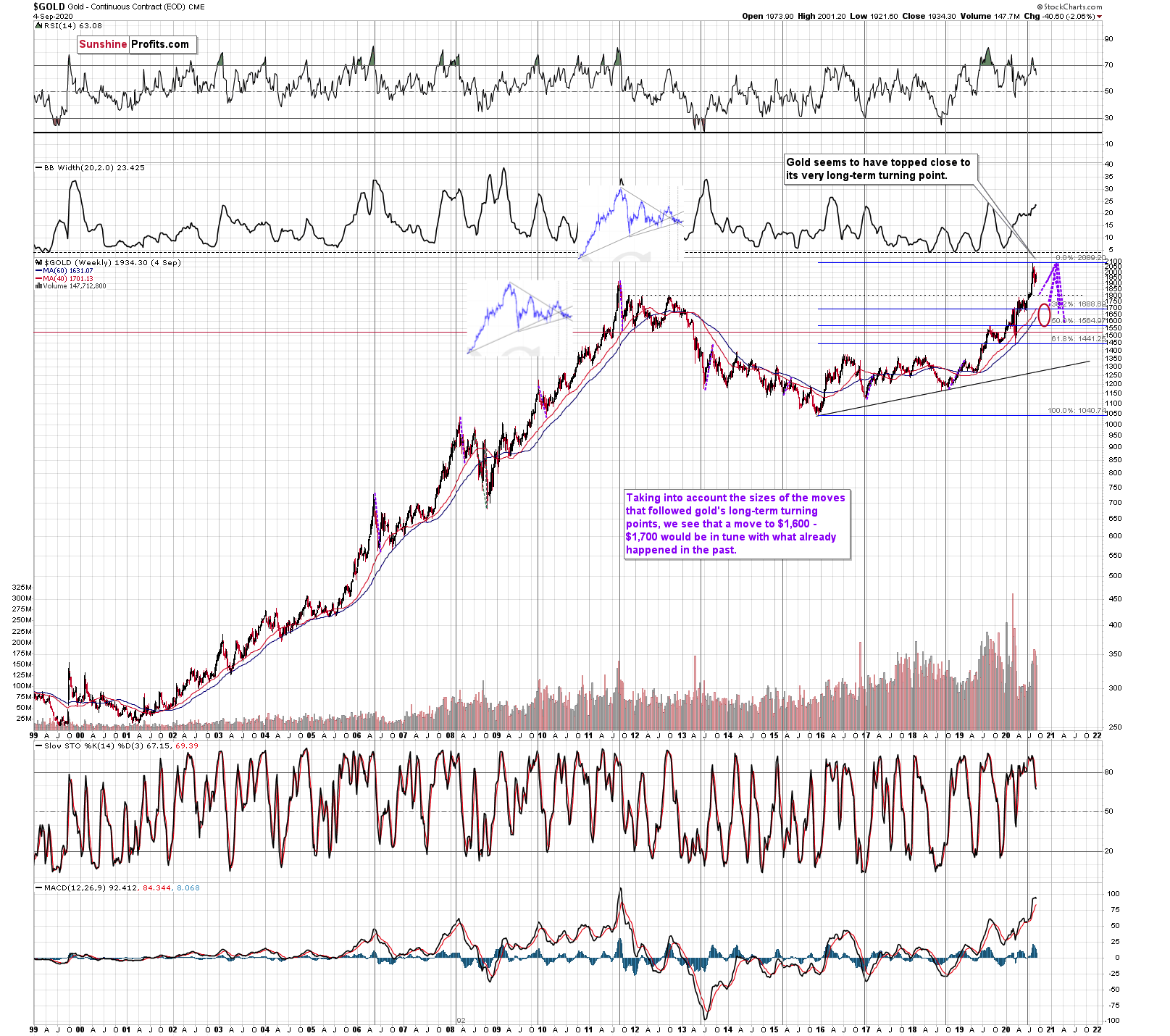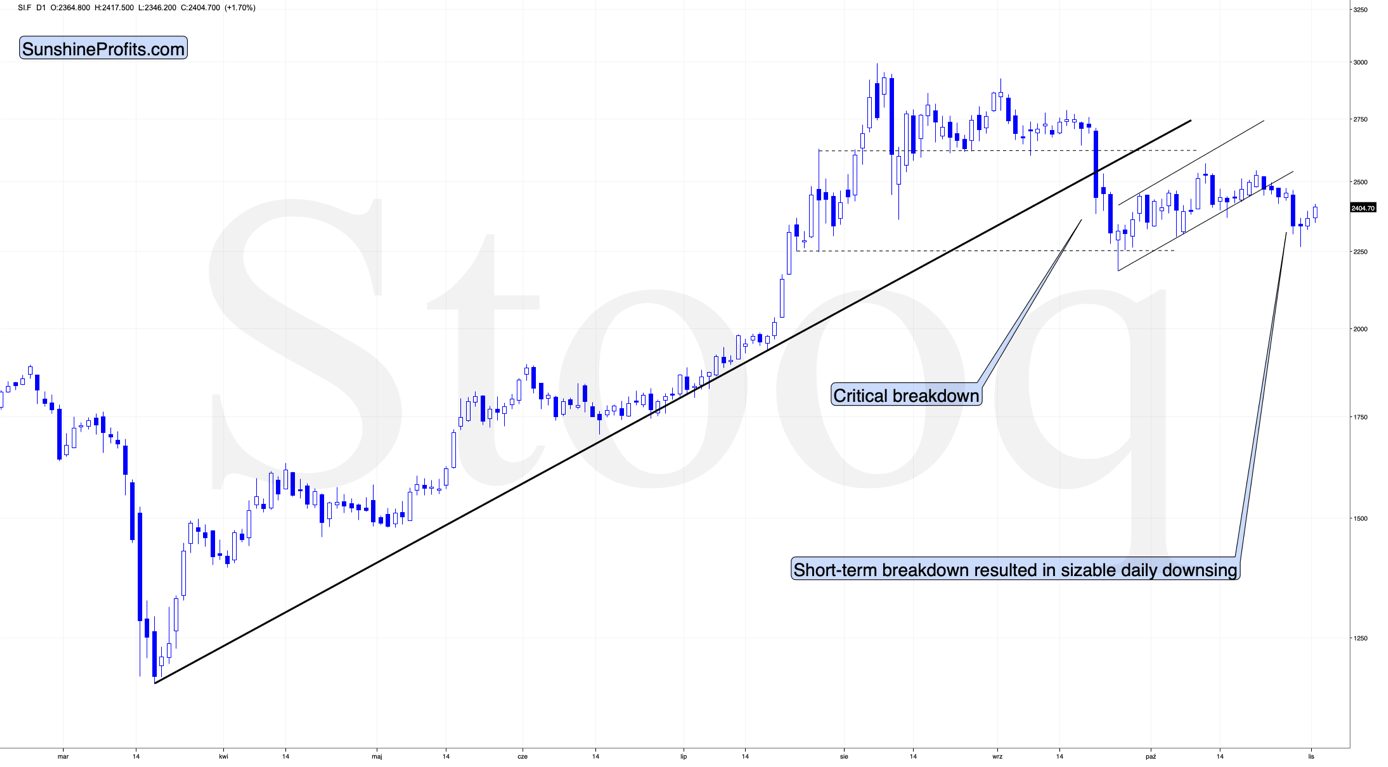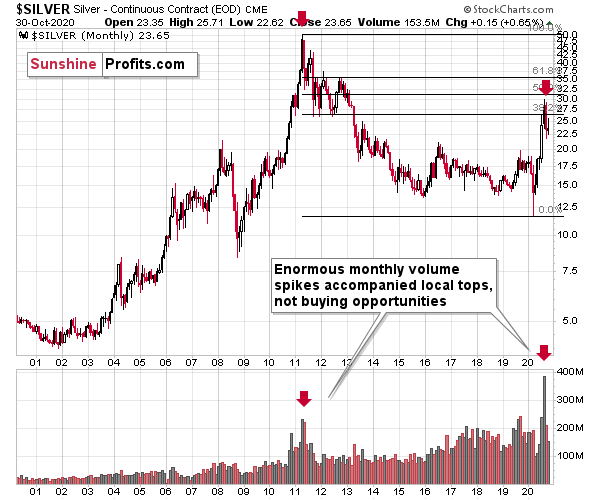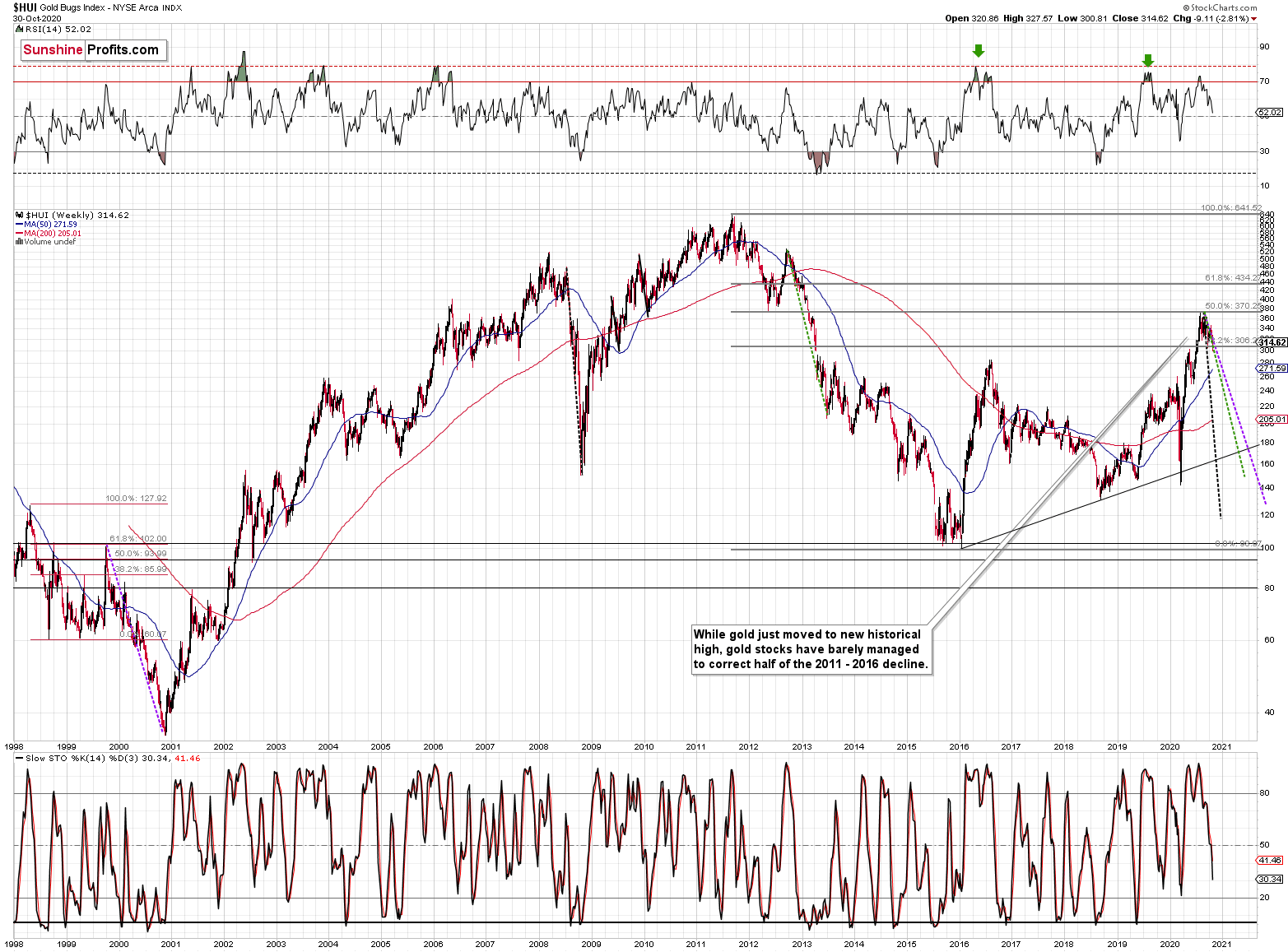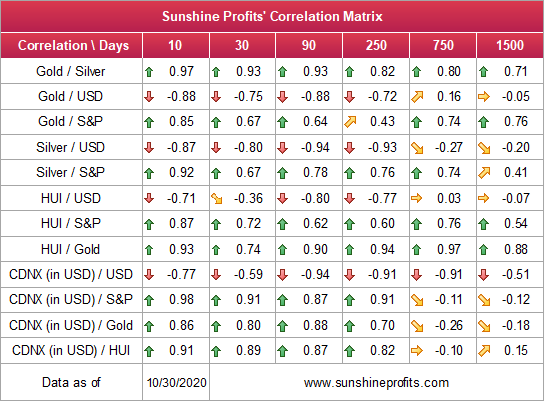Briefly: The precious metals market will most likely move to the downside but the metals’, miners’ and the USD Index behavior are behaving and the 2016 (previous presidential elections in the U.S.) correlation suggest that we might see one final move higher in the next few days before the slide gains momentum.
Welcome to this week's Gold Investment Update. Predicated on last week’s price moves, our most recently featured outlook remains the same as the price moves align with our expectations. On that account, there are parts of the previous analysis that didn’t change at all in the earlier days, which will be written in italics.
Before discussing the technical point of view, we’d like to say a few words on the upcoming US elections, the Covid-19 situation, the stimulus package(s) related to the latter, and the recent real interest rates moves.
Election Day is almost here. Who will win, and why gold will remain the biggest winner of them all?
Tomorrow is the big day! The Election Day. For quite some time, national polls indicate that Biden has a significant advantage. He is also polling scarcely close ahead of Donald Trump in key battleground states. But, in some states, the lead has recently narrowed. So, in many places, the race is still too close to call, making them toss-up states. Hence, although according to political pundits, polls, and bets Biden will become the next POTUS, anything could happen.
And we mean - anything. Everyone knows that back in 2016, Hillary Clinton also led in the polls. However, Trump won the election. Of course, the polling methodology has been improved since. But now, Biden has a much wider advantage than Hillary did in 2016, and he is much more conservative and more moderate in his approach than Clinton (historically, more moderate presidential candidates generally do better in presidential elections).
Additionally, the election results might not be known right away, and there are indications that they might be contested. Who knows what could happen if that’s the case? According to some analysts, contested elections should increase the geopolitical uncertainty and boost the safe-haven demand for gold. On the other hand, some analysts also believe that the contested elections would put downward pressure on the stock market, dragging gold down in the process. The fact of the matter is that contested elections would undoubtedly delay the fiscal stimulus package, which should be negative for gold prices.
So, who is right? It is true that recently, gold has been moving in tandem with the stock prices, responding to the stimulus expectations. But, in times of stress and reduced faith in the American institutional system, gold could decouple from equities and behave more like a safe haven asset.
In any case, on Wednesday, the elections will already be behind us. Hopefully, we will get the results quickly. No matter who wins, the new administration and the new Congress will have to deal with the second (or should one call it third already?) wave of the coronavirus and fragile economic recovery.
Oh, and by the way, as the chart below shows, the US reported 101,273 new Covid-19 cases on Saturday, the new daily record not only for America, but for any country! According to some epidemiologists, the worst is yet to come –that is, if the upward trend in cases continues, overwhelming the health system as a result.
No matter whether red or blue, the new government is likely to pump more liquidity into the economy. Therefore, gold could thrive equally well under Trump or Biden, although we could see an increased volatility in the short-term precious metals market.
So, what does all the above mean for the gold market? Well, investors should look past the elections already. They are far less important than many people believe, at least as far as gold is concerned. The 2016 presidential election is the best example of that. The gold price indeed declined in the aftermath of Trump’s victory, but the downward trend was eventually reversed.
So, yes, you should be prepared for an elevated volatility this week. After all, we are about to witness not only the elections, but the FOMC meeting and the equally important economic reports, including the nonfarm payrolls.
But still, as I have repeated many times before, gold’s responses to geopolitical events are relatively short-lived. In the long run, what drives gold prices are the fundamental factors. And the fundamental outlook remains positive for the yellow metal. Both the monetary and the fiscal policy are extremely dovish. The public debt is ballooning, while the US dollar is weakening. The real yields remain negative.
Yes, as the chart below shows, the real interest rates have stabilized or even increased slightly since August, which explains gold’s struggle in recent months.
Nevertheless, the Fed will maintain its policy of ultra-low nominal interest rates for years, while inflation will accelerate at some point, possibly when the economic recovery sets in for sure. This means that the real interest rates should remain very low or even decrease further, supporting the gold prices in the process.
All in all, there are multiple fundamental reasons why gold is likely to soar in the upcoming years. However, even the most profound bull markets can’t move up in a straight line, and some corrections will likely take place. After the big rallies, we will probably witness significant corrections, and in the case of the precious metals market, one is long overdue.
Much like in March, it seems that the evident economic decline might trigger a sell-off.
At this point, we would like to quote what we wrote about the aspects of the virus scare and how the market reacts to them. In short, gold (and other markets) reacted when people started to strongly consider the pandemic's economic implications, a topic that was ubiquitous in the media.
Undoubtedly, the most important factor for gold will be the economic implications of the second Covid-19 wave. How do we know that? Because we compared what people were searching for (online) with how the gold prices were shaped. There's a lot more data available on https://searchingcovid19.com/, but we'll focus on the chart that shows us exactly when people were getting interested in each aspect of the pandemic, and we'll compare that to gold.
We aligned both charts regarding time. The chart on the bottom is from Stockcharts.com and it features gold's continuous futures contract. The gold price (and the USD Index value) really started to move once people got particularly interested in the economic impact of the pandemic and in the government's response.
In recent days (and weeks) the news is dominated by other issues. Once people start considering the economic implications of the second wave of this coronavirus, the prices would be likely to move.
The news coming from the Fed is positive for gold in the long run, but in the short term, they continue to indicate risk for the economy. This risk is likely to translate into lower stock values and initially gold is likely to slide given the above - just like it did in March.
All in all, gold is likely to rally far in the long run, but in the short run it’s vulnerable to a sizable decline, when the economic implications of the pandemic’s continuation become obvious to investors.
Crude Oil – PM’s Early Bird
In early 2020, crude oil heralded the declines, by declining first, which ultimately undermined the stock market. One of the first things that followed was the severe decline in gold, silver, and mining stocks, and thus, witnessing what’s currently happening to crude oil prices would be very useful from a precious metals’ investors’ POV. For that reason, we’ll quote our comments from today’s Oil Trading Alert below (on a side note, our short position in crude oil just got more profitable based on today’s pre-market slide):
Crude oil started this week with a bearish price gap and a breakdown below the September and October lows. This is an extremely valuable indication. The black gold seems to have finally decided what the next big move is going to be, and by breaking lower, it effectively “agreed” with our expectations.
On its own, the breakdown is very bearish. However, what preceded is equally important, as it shows that this move has much more potential than just a few-dollar drop.
First of all, crude oil stopped rallying after correcting approximately 61.8% of the previous 2020 decline, which means that it was quite likely a real top instead of a fake one that will be broken shortly.
Second, the initial decline was followed by a zigzag, which is a classic corrective pattern. Since the preceding move lower was to the downside, the end of the correction insinuates another decline.
Third, the Stochastic indicator is on a sell signal.
Finally, it’s all similar to what we saw in Q1 2020, not just the breakdown in crude oil, but the fact that it had first corrected a bit above the 61.8% of the preceding decline, and that stocks were forming a double-top pattern.
Of course, we’ll know about the final point (stock’s double top) only after they decline further, however the shape of the price moves (lower part of the above chart) is already similar.
The Covid-19 cases are soaring once again as well, and even though the fear of the unknown is not present this time, the scale of the phenomenon is much greater, and thus the emotional reaction is also getting more serious. And the above charts reflect that. Just as it was the case in January and February, crude oil is the first to show weakness, but it’s definitely not the last to do so.
The USD Index has already confirmed its breakout and is rallying almost on a daily basis, so things do really look like they looked in the first quarter of the year.
And speaking of the USD Index and stocks, let’s take a closer look at them.
Stocks and the Dollar Weigh In
It’s evident that stocks have once again invalidated the breakout above their early-2020 high. They have also closed the week below the lowest weekly September close. Back in September, the S&P 500 index reversed on a weekly basis and rallied once again. This is similar to what happened in 2018 (August) when stocks first broke to new highs. Back then, the volatility was lower, and therefore it’s no wonder that the breakout held and this time (in September) it was temporarily invalidated.
Back in 2018, stocks moved to a new high (not significantly higher), and this time they didn’t manage to do so, but were quite close (the rally seems to have burned itself out in August).
The key take-away from this similarity is that once stocks slide below the September lows in intraday terms, they are likely to decline further. Perhaps much lower.
Back in 2018, stocks consolidated around the previous lows, and then they declined even more profoundly in the final part of the year. Could the same happen this time as well? Well, it could happen, but with so much money being injected into the system from various directions, we don’t want to say that it's inevitable.
What is very likely in my view, however, is that stocks will slide, and when they do, they will take the precious metals sector with it. Especially silver, and mining stocks.
Moreover, let’s keep in mind that the situation continues to be excessive on the forex market.
Remember when in early 2018 we wrote that the USD Index was bottoming due to a very powerful combination of support levels? Practically nobody wanted to read that as everyone “knew” that the USD Index is going to fall below 80. We were notified that people were hating on us in some blog comments for disclosing our opinion - that the USD Index was bottoming, and gold was topping. People were very unhappy with us writing that day after day, even though the USD Index refused to soar, and gold was not declining.
Well, it’s exactly the same right now.
The USD Index was at a powerful combination of support levels. One of them is the rising, long-term, black support line based on the 2011 and 2014 bottoms. The other major support level and a long-term factor is the proximity to the 92 level – that’s when gold topped in 2004, 2005, and where it – approximately – bottomed in 2015, and 2016.
The USDX just moved to these profound support levels, broke slightly below them, and now it has clearly invalidated this breakdown. For many weeks, we’ve been warning about the likely USD Index rally, and we finally saw it.
Quoting my previous comments:
USD Index moved briefly below the long-term, black support line and then it invalidated this breakdown before the end of the week. This is a very bullish indication for the next few weeks.
Before moving to the short-term chart, please note that the major bottoms in the USD Index that formed in the middle of the previous years often took form of broad bottoms.
Consequently, the current back and forth trading is not that surprising. This includes the 2008, 2011, and 2018 bottoms.
A crucial aspect is that the rally that we’ve witnessed so far is just the tip of the bullish iceberg. The breakdown below the key support levels was invalidated, which is a strong bullish indicator. Since it happened on a long-term chart and the temporarily broken lines were critical, the implications are incredibly important as well– and they should be visible from the long-term perspective.
So, how high could the USD Index rally now? At least to the 100 level (approximately). This way, the upcoming rally would almost match the rally that started after the previous major invalidation – the 2018 one.
Still, we wouldn’t rule out a scenario in which the USD Index rallies above its 2020 highs before another major top. After all, the USD Index is after a very long-term breakout that was already verified several times.
Taking into account USDX’s lengthy breakout, its several breakout verifications, and the 5-year consolidation, it seems that the USD Index is ready to rally much higher – perhaps to approximately to the 120 level.
Please note that the consolidation that preceded the previous rally to 120 that took place between 1997 and 2000 happened when the USD index was trading at relatively similar price levels – approximately between 90 and 105.
The short or medium-term target for the USDX is relatively unclear right now, and it’s very oversold on a short-term basis. It all happened in the middle of the year, which is when on many occasions, the USDX formed major bottoms. This makes a short-term rally here very likely.
The short-term USD Index chart is not as important as the long-term one, but let’s take a look at it anyway.
On Friday, we commented on the chart above in the following manner:
Namely, it broke above its declining short-term resistance line, and it’s holding above it also in today’s pre-market trading. This is bullish, and it will become more bullish once the USDX manages to verify this breakout by closing above it for the next two trading days. The implications for the precious metals market are bearish.
It could be the case that the USD Index pauses before the elections and continues its move only after the uncertainty regarding the outcome is gone.
The USD Index corrected slightly after moving higher earlier today, so the above clearly remains up-to-date.
In fact, I wouldn’t be surprised to see a corrective move lower that would trigger a brief move higher in the precious metals and mining stocks. However, that would only be temporary, and not likely to last more than several days.
Overall, as the outlook remains bullish for the USD Index, it remains bearish for the precious metals sector. This is particularly the case if we take into account that recently, the Gold Miners Bullish Percent Index showed the highest possible overbought reading.
The excessive bullishness was present at the 2016 top as well and it didn’t cause the situation to be any less bearish in reality. All markets periodically get ahead of themselves regardless of how bullish the long-term outlook really is. Then, they correct. If the upswing was significant, the correction is also quite often significant.
Please note that back in 2016, there was an additional quick upswing before the slide and this additional upswing has caused the Gold Miners Bullish Percent Index to move up once again for a few days. It then declined once again. We saw something similar also this time. In this case, this move up took the index once again to the 100 level, while in 2016 this wasn’t the case. But still, the similarity remains present.
Back in 2016, when we saw this phenomenon, it was already after the top, and right before the big decline. Given the situation in the USD Index, it seems that we’re seeing the same thing also this time.
Please note that back in 2016, after the top, the buying opportunity didn’t present itself until the Gold Miners Bullish Percent Index was below 10. Currently, it’s above 50, so it seems that miners have a long way to go before they bottom (perhaps a few months – in analogy to how gold declined in 2016).
On Thursday, after gold had declined significantly (on Wednesday), we wrote the following:
Miners have been undermining gold, which is bearish, and they have also broken below the recent lows, which is also bearish. Moreover, miners have just declined on strong volume after opening the day with a price gap, which at first sight, is bearish.
The theory is that such sessions are particularly bearish, as they supposedly show the bears' strength. But, before applying any trading tip into practice, it’s important to check if it had indeed worked on a given market, especially in the recent past. And the aforementioned did work… In the opposite way!
For the third time, miners are declining substantially during one day on a strong volume. We saw the same thing happening in mid-August and late-September. None of them were followed by lower miner prices. Instead, we’ve witnessed corrective upswings that didn’t change the overall downtrend.
So, from here on in, will miners rally or decline? Overall, the very near term (until the elections in the U.S. and a day-two after that) is unclear. At this point, a temporary rebound here would not surprise me at all, and if we see one, I expect it to be followed by a major slide. That’s precisely what happened right before and after the elections in 2016.
The above summary remains 100% up-to-date. Miners moved a bit higher and given today’s pre-market upswing in gold they might also rally during today’s session. Still, it’s likely nothing more than a pre-election uncertainty that drives the prices that are likely to subside shortly.
Also, let’s not forget that the GDX ETF has recently invalidated the breakout above the 61.8% Fibonacci retracement based on the 2011 – 2016 decline.
When GDX approached its 38.2% Fibonacci retracement, it declined sharply – it was right after the 2016 top. Are we seeing the 2020 top right now? This is quite possible – PMs are likely to decline after the sharp upswing, and since there are only several months left before the year ends, it might be the case that they move north of the recent highs only in 2021.
Either way, miners’ inability to move above the 61.8% Fibonacci retracement level and their invalidation of the tiny breakout is a bearish sign.
The same goes for miners’ inability to stay above the rising support line – the line that’s parallel to the line based on the 2016 and 2020 lows.
Let’s proceed to metals themselves.
Once again, let’s quote Thursday’s comments:
Once again, it moved below the declining support line, which previously served as resistance. In other words, it invalidated its recent breakout. This is clearly bearish, but since gold is trading so close to this line, it might make another attempt to move higher any day or hour now.
Another attempt that fails very close to the U.S. election would be a perfect start for the next big wave down.
Gold is indeed making another attempt to rally above the declining resistance line. After the U.S. elections it could fail just as indicated above. This would be a great start for another big wave lower.
Before moving further, I would like to stress that according to the chart above, the likely downside target for gold is at about $1,700, predicated on the previous lows and the 61.8% Fibonacci retracement, based on the recent 2020 rally.
Having said that, let’s focus on the fact that gold recently failed to move above its previous long-term (2011) high. Since history tends to repeat itself, it’s only natural to expect gold to behave as it did during its previous attempt to break above its major long-term high.
And the only similar case is from late 1978 when gold rallied above the previous 1974 high. Let’s take a look at the chart below for details (courtesy of chartsrus.com)
As you can see above, in late 1978, gold declined severely right after it moved above the late-1974 high. This time, gold invalidated the breakout, which makes the subsequent decline more likely. And how far did gold decline back in 1978? It declined by about $50, which is about 20% of the starting price. If gold was to drop 20% from its 2020 high, it would slide from $2,089 to about $1,671.
This is in perfect tune with what we described previously as the downside target while describing gold’s long-term charts:
The chart above shows exactly why the $1,700 level is even more likely to trigger a rebound in gold, at the very minimum.
The $1,700 level is additionally confirmed by the 38.2% Fibonacci retracement based on the entire 2015 – 2020 rally.
There’s also possibility that gold would decline to the $1,500 - $1,600 area or so (50% Fibonacci retracement and the price level to which gold declined initially in 2011), but based on the size of the recent upswing, we no longer think that this scenario is the most likely one.
Gold is (from the long-term point of view) after its very long-term turning point, and since the most recent move has been to the upside, its implications are bearish.
We used the purple lines to mark the previous price moves that followed gold's long-term turning points, and we copied them to the current situation. We copied both the rallies and declines, which is why it seems that some moves would suggest that gold moves back in time - the point is to show how important the turning point is in general.
Based on the information that we have available right now, it seems likely that gold will bottom close to the $1,700 level. That’s very much in tune with how much gold moved after the previous long-term turning points.
Speaking of upside targets, nine weeks ago, we wrote:
Based on gold's Fibonacci extensions and the previous major highs and lows (the 2018 high and late-2019 low along with the 2020 low), we get a nearby upside target of $2085. At the moment of writing these words, gold is trading at $2044. Given this week's volatility, it could even be a matter of hours before gold reaches the above-mentioned target and reverses. Taking closing prices into account, gold is up by $35, so if it reverses significantly, we would be likely to see a powerful weekly reversal candlestick and one that causes gold to decline in the following weeks.
That’s more or less what happened. Gold topped at $2,089.20. It then declined quite visibly and closed last week at about $1,950.
Do you get the feeling that you have already seen gold perform this way before? Because you did.
The history rhymes, but this time, the similarity is quite shocking.
We copied the short-term chart and pasted it on the long-term chart above and next to the 2011 top. We pasted it twice, so that you can easily compare gold’s performance in both cases in terms of both: price and time.
They are very similar to say the least. Yes, these patterns happened over different periods, but this doesn’t matter. Markets are self-similar, which is why you can see similar short-term trends and long-term trends (with regard to their shapes). Consequently, comparing patterns of similar shape makes sense even if they form over different timeframes.
After a sharp rally, gold declined quickly. Then we saw a rebound, and a move back to the previous low. Then, after a bit longer time, gold moved close to the most recent high and started its final decline. This decline was less volatile than the initial slide. That’s what happened when gold topped in 2011 (and in the following years), and that’s what happened also this year. Ok, after the initial decline from the 2011 top, we saw two initial reactive rallies and in 2020 there was just one, but it didn’t change the similarity with regard to time.
The patterns of this level of similarity are rare, and when they do finally take place, they tend to be remarkably precise with regard to the follow-up action.
What is likely to follow based on this pattern, is that we’re likely to see the end of the slower decline, which will be followed by a big and sharp decline – similarly to what we saw in 2013.
How low could gold slide based on this similarity? Back in 2013, gold declined approximately to the 61.8% Fibonacci retracement based on the preceding rally (the one that started in 2008), so that’s the natural target also this time.
And we already wrote about this particular retracement – it’s approximately at the $1,700 level. This has been our downside target for weeks, and it was just confirmed by this precise self-similar technique.
Another interesting point is that gold made an interim low close to the 50% retracement and the previous lows. Applying this to the current situation suggests that we could see a smaller rebound when gold moves to about $1,760 - $1,800.
This might be the moment to switch from short positions in the miners to short position in silver. It’s too early to say for sure at this time, though.
As far as the white metal is concerned, on September 24th, we have warned you about the possible temporary rebound:
Silver is also after a major breakdown and it just moved slightly below the recent intraday lows, which could serve as short-term support. This support is not significant enough to trigger any major rally, but it could be enough to trigger a bounce, especially if gold does the same thing.
That’s exactly what happened.
So, is the counter-trend rally over? That’s quite possible, particularly if we consider the USDX breakouts. However, given the pre-election uncertainty, silver could move somewhat higher before it slides once again.
In early March, silver moved higher before truly plunging, so the current move up doesn’t invalidate this similarity, especially that the coronavirus cases are rising in a quite similar way (this similarity is most visible in Europe).
Moreover, please note that from the long-term point of view, silver is not that strong.
While gold moved to new highs, silver – despite its powerful short-term upswing – didn’t manage to correct more than half of its 2011 – 2020 decline.
In fact, silver has already invalidated its move above the lowest of the classic Fibonacci retracement levels (38.2%), which is not something that characterizes extraordinarily strong markets.
Silver is likely to move well above its 2011 highs, but it’s unlikely to do it without another sizable downswing first.
If you look at the monthly silver volume levels, it seems likely that the next sizable downswing has already begun. The previous substantial monthly volume in silver accompanied the 2011 top. The analogy doesn’t get more bearish than this. Ok, it would, if there were multiple key tops confirmed by huge monthly volume. But the 2011 top was so significant that other tops are not comparable, except for the most recent one. Thus, the implications are bearish.
We are witnessing something similar in the HUI Index as well. The latter corrected half of its 2011 – 2016 decline and nothing more, while gold moved well above its 2011 high.
All in all, it’s mostly gold that is making the major gains – not the entire precious metals sector.
So, how can one determine the end of the gold price decline? At $1,700, it seems that it can go either up or down. Where does gold need to go to complete the pattern?
In reality, gold could rebound from $1,700, but it could just as well slide further, perhaps once again to the previous 2020 lows, especially if the USDX rallies to its 2020 highs.
So, how do we determine whether we see the buying opportunity or not?
We will view the price target levels as guidelines, and the same goes for the Gold Miners Bullish Percent Index (below 10), but the final confirmation will likely be something else. Something that we already saw in March when gold bottomed.
We will be on a special lookout for gold’s strength against the ongoing USDX rally. At many vital bottoms in gold, that’s exactly what happened, including what was the March bottom.
So far, the link between gold and the USD Index is strongly negative.
Since gold, silver, and mining stocks have been strongly negatively correlated with the USD Index in the short (30-day column) and medium term (90-day column), it seems likely that will continue to be negatively affected by the USDX upswing.
…Until we see the day where gold reverses or soars despite the U.S. currency’s rally.
If that happens with gold at about $1,700, we’ll have a very good chance that this was the final bottom. If it doesn’t happen at that time, or gold continues to slide despite USD’s pause or decline, we’ll know that gold has further to fall.
Naturally we’ll keep you – our subscribers – informed.
To move forward, how does the GDX downside target compare to the gold’s downside target? If, at the same time, gold moves to about $1,800 and miners are already after a ridiculously big drop (to $31-$32 in the GDX ETF, or lower), the binding profit-take exit price of your GDX ETF will become $32.02.
However, since gold is only at $1,800, with a GDX of $32, there’s more decline to be expected. Perhaps that exiting GDX is only for changing to shorts in silver? Is that the only instance when that’s the case, or could it also be with a GDX of $32 and a gold price of $1,700. What would be a GDX target for gold at a gold price of $1700 be?
It’s also not entirely clear whether you have up to six weeks until the lows arrive, instead of the end of the year.
Yes, we plan to exit the short positions in the mining stocks (GDX) and enter short positions in silver. We don’t have an exact price at which we’ll do it (and it’s unclear if we’ll do it at all). We’re just describing what we’re going to do if a certain set of circumstances is met. If miners decline very profoundly, but silver declines only “normally”, then it would create a specific opportunity for one to switch from miners (that would be after most of their decline) to silver (that would not be after most of its decline). Our estimation is that it might happen with GDX at about $31 - $32, and/or with gold at about $1,800. However, it would be the specific relative performance of miners to silver that would determine if we would make the switch or not.
We expect the above – a local bottom with miners at about $31 - $32 – to form within the next 5 weeks. However, this will likely not be the final bottom, especially if gold doesn’t slide to $1,700 at that time. We expect to see bigger declines to follow then, after a pause or a rebound. This means that miners could rally a bit from $31 - $32, and then decline below this area afterward.
At this time, the final GDX target (the one that would correspond to gold at $1,700 or lower) is still unclear. The $17 - $23 area seems probable, especially if the general stock market slides once again. It’s too early to say with any significant level of certainty. Gold is providing us with a clearer final target, so that’s what we’ll focus on. And most importantly – we’ll focus on gold’s performance relative to the USD Index.
- Overview of the Upcoming Decline
As far as the current overview of the upcoming decline is concerned, I think it has already begun.
During the final part of the slide (which could end later than in 6 weeks, perhaps near the end of the year – just like it happened in 2015), we expect silver to decline more than miners. That would align with how the markets initially reacted to the Covid-19 threat.
The impact of all the new rounds of money printing in the U.S. and Europe on the precious metals prices is incredibly positive in the long run, which does not make the short-term decline improbable. Markets can and will get ahead of themselves and decline afterward – sometimes very profoundly – before continuing with their upward climb.
The plan is to exit the current positions in miners after they decline far and fast, but at the same time, silver drops just “significantly” (we expect this to happen in 0 – 5 weeks). In other words, the decline in silver should be severe, but the decline in the miners should look “ridiculous”. That’s what we did in March when we bought practically right at the bottom. It is soft, but at the same time, a broad instruction, so additional confirmations are necessary.
I expect this confirmation to come from gold, reaching about $1,800. If – at the same time – gold moves to about $1,800 and miners are already after a ridiculously big drop (say, to $31 - $32 in the GDX ETF – or lower), we will probably exit the short positions in the miners and at the same time enter short positions in silver. It will be tempting to wait with opening the short position in silver until the entire sector rebounds, but such a rebound could last only a couple of hours, so it would be challenging to successfully execute such a strategy.
The precious metals market's final bottom is likely to take shape when gold shows significant strength relative to the USD Index. It could take the form of a gold’s rally or a bullish reversal, despite the ongoing USD Index rally.
Summary
Summing up, the next big move in the precious metals market is likely to be to the downside (as further indicated by action in crude oil), but the way in which metals’, miners’ and the USD Index are behaving right now as well as the analogy to 2016 (previous presidential elections in the U.S.) suggest that we might see one final pop up higher in the next few days before the slide gains momentum.
Considering gold's breakout invalidation above the 2011 highs, it's evident that the big rally (that ended $4 above our upside target) is entirely over. Given this invalidation and the confirmed USD Index breakout, gold will probably slide much lower over the next few weeks. There are indications that the corrective upswing in the precious metals market and the pullback in the USDX are close to being over, so the decline could resume any day – or hour – now.
Naturally, everyone's trading is their responsibility. But in our opinion, if there ever was a time to either enter a short position in the miners or increase its size if it was not already sizable, it's now. We made money on the March decline, and on the March rebound, with another massive slide already underway.
After the sell-off (that takes gold to about $1,700 or lower), we expect the precious metals to rally significantly. The final decline might take as little as 1-6 weeks, so it's important to stay alert to any changes.
Most importantly, please stay healthy and safe. We made a lot of money on the March decline and the subsequent rebound (its initial part) price moves (and we'll likely earn much more in the following weeks and months), but you have to be healthy to enjoy the results.
As always, we'll keep you - our subscribers - informed.
To summarize:
Short-term outlook for the precious metals sector (our opinion on the next 1-6 weeks): Bearish
Medium-term outlook for the precious metals sector (our opinion for the period between 1.5 and 6 months): Bearish initially, then possibly Bullish
Long-term outlook for the precious metals sector (our opinion for the period between 6 and 24 months from now): Bullish
Very long-term outlook for the precious metals sector (our opinion for the period starting 2 years from now): Bullish
Our preferred ways to invest in and to trade gold along with the reasoning can be found in the how to buy gold section. Additionally, our preferred ETFs and ETNs can be found in our Gold & Silver ETF Ranking.
As a reminder, Gold & Silver Trading Alerts are posted before or on each trading day (we usually post them before the opening bell, but we don't promise doing that each day). If there's anything urgent, we will send you an additional small alert before posting the main one.
Thank you.
Sincerely,
Przemyslaw Radomski, CFA
Editor-in-chief, Gold & Silver Fund Manager


